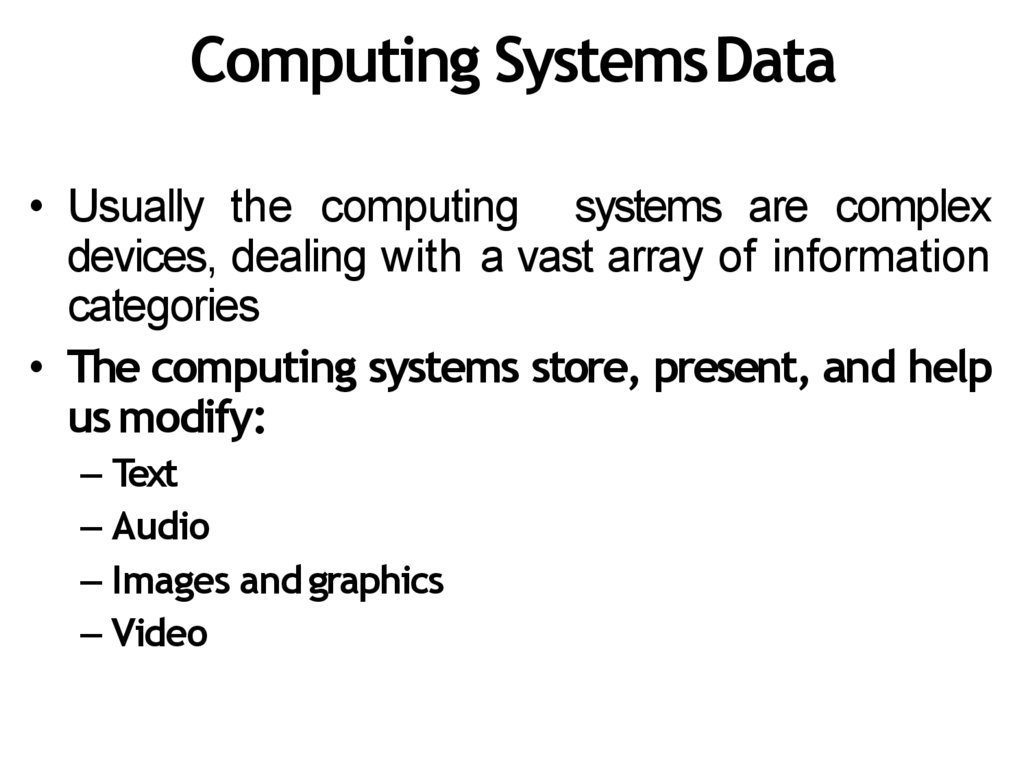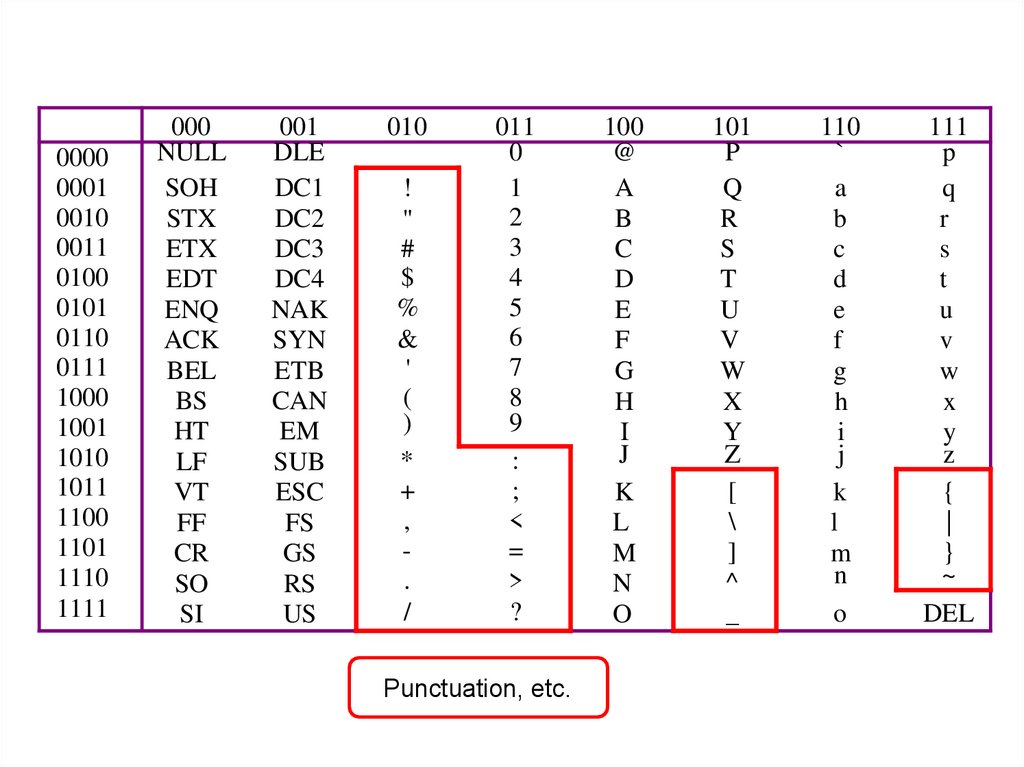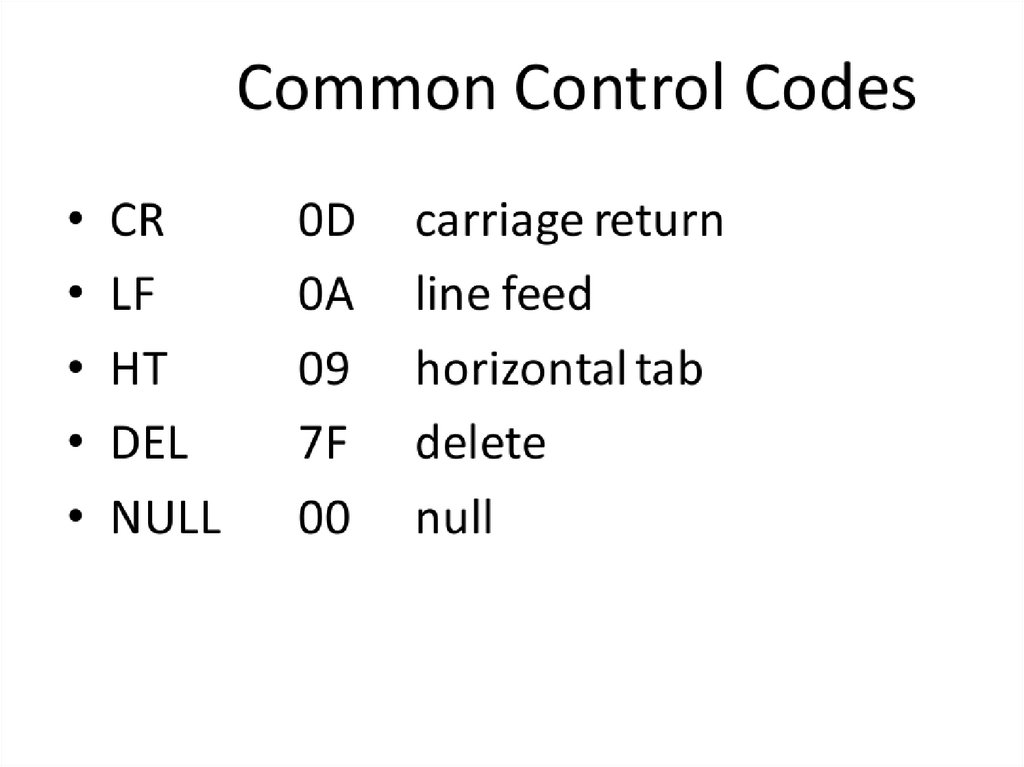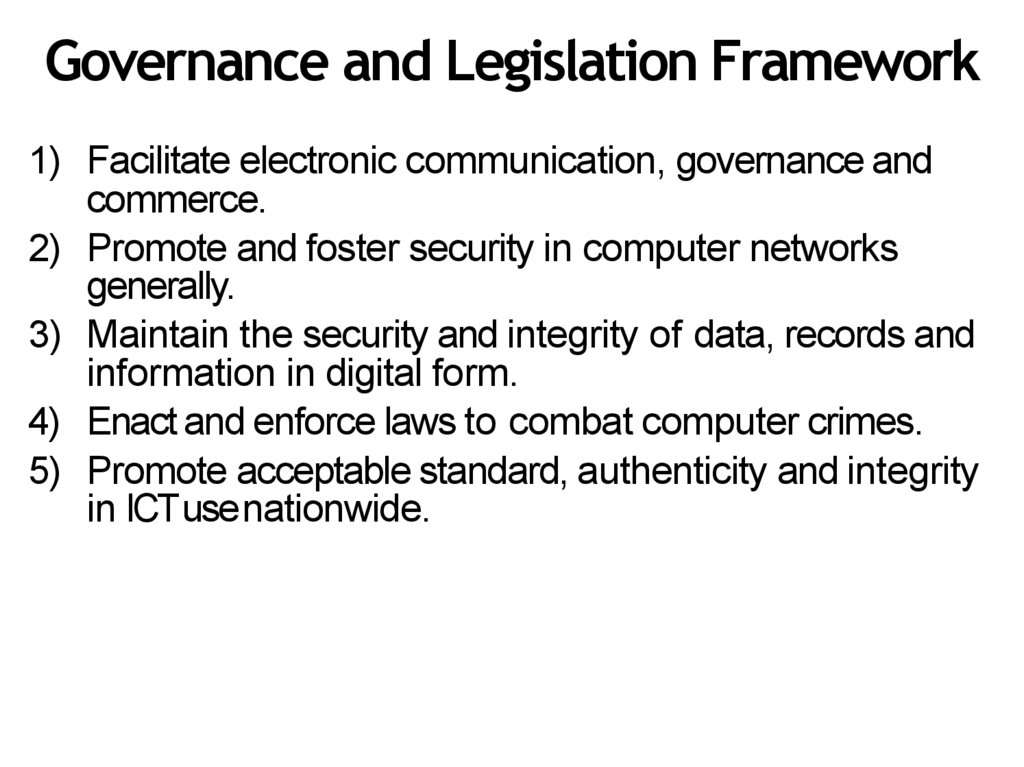Similar presentations:
Information and communication technologies
1.
Information and communicationtechnologies
2.
Plan:• Lecture1. ICTrole in key sectors of development
of society. Standards in the field of ICT;
• Lecture2.Introduction to computer systems.
Architecture ofcomputer systems;
• Lecture 3. Software. Operatingsystems;
• Lecture 4. Human-computerinteraction;
• Lecture 5. Databasesystems;
• Lecture 6. Data analysis. Datamanagement;
• Lecture 7. Networksand telecommunications;
3.
Plan:Lecture 8. Cybersafety;
Lecture 9. Internet technologies;
Lecture10. Cloud and mobile technologies;
Lecture 11. Multimedia technologies;
Lecture 12. SmartTechnology;
Lecture 13. E-technologies. Electronicbusiness.
Electronic learning. Electronicgovernment;
• Lecture14. Information technologies in the
professional sphere. Industrial ICT;
• Lecture15. Prospects of development of ICT.
4.
ICT role in key sectors ofdevelopment of society. Standards in
the field of ICT
5.
Contents:Definition of ICT;
ICT subject and its objectives;
ICT in key sectors of society;
Advantages of computers and disadvantages of
computers;
• Data representation;
• Standards in the field of ICT;
• Connectionbetween ICT and achievement of
the objectives of a sustainable development.
6.
ICT (information and communicationstechnology - or technologies) is an common term
that includes any communication device or
application, such us: radio, television, cellular
phones, computer and network hardware and
software, satellite systems and so on, as well as the
various services and applications associated with
them, such as videoconferencing and distance
learning. ICTs are often spoken of in a particular
context, such as ICTs in education, health care, or
libraries.
7.
Definition of ICT(1)ICT is defined as an industry, i.e. as a set of
enterprises and organizations engaged in economic
activities related to the design, production and
trade of software, computing, communications
equipment, consumer electronics and its
components, as well as system integration, with
the provision of telecommunication and
information technology services (According to the
Order of the Minister of Transport and
Communications of the Republic of Kazakhstan in
Industry frame ofqualifications).
8.
Definition of ICT(2)Information and communication technologies (ICT)
are regarded as modern methods and means of
communication of people in a normal and
professional activities with the help of information
technologies for the search, collection, storage,
processingand dissemination of information.
9.
Definition of Development Program ofOrganization of United Nations in 2003
ICT is, mainly, a tool for processing information - a
wide range of products, software and services that are
used for production, storage, processing, distribution
and exchange of information. They also include "old"
ICTs, including radio, TV and telephone, as well as
"new" ICT: computers, satellite systems and wireless
technologies and the Internet. These different tools are
now able to work together, and together they make up
our "network world", a gigantic structure of the
combined telephone networks, standardized computer
hardware, Internet, radio and television, while using
these components can be easily accessed in anywhere
in the world.
10.
Subject of ICT andpurposeDiscipline "ICT" is used for the formation of a particular
ideology in the field of information and modern
information culture, i.e. the ability to interact with
information, professional use for receiving, processing,
transmitting and storing it.
11.
Computers insociety• Home -
• Education • Small business • Industry –
Games, surf the Internet,communicate
with friends and family, video, music,…
Finding information on theInternet,
access to libraries, …
Reports, calculations, …
Robotics, enterprise management,
manufacturing automation , …
Egov.kz
Government Expert systems,…
Health careElectronic payments, electronic transfers
Banking Local networks, global networks, …
Communication Police Department - Database, video surveillance,…
Retail Internet shops,…
12.
Advantages of computersSpeed
Reliability
Storage
Consistency
Communica
tions
13.
Speed Up WorkEfficiencyThis is by far the biggest advantage of using
computers. They have replaced the use of
manpower in carrying out tedious and repetitive
work. Work that can take days to complete
manually can be done in a few minutes using a
computer. This is made possible by the fact that
data, instructions and information move very fast
in the electric circuits of computers. They process
trillionsof instructionswithin a second.
14.
Large and Reliable StorageCapacityComputers can store huge volumes of data. To put this
into perspective, physical files that can fill a whole
room can be stored in one computer once they are
digitized. Better yet, access to the stored information is
super-fast. It takes micro-seconds for data to be
transferred from storage to memory in a computer.
The same cannot be said for the retrieval of physical
files. With a computer, you can store videos, games,
applications, documents etc. that you can access
whenever required. Better yet, storage can be backed
up fast andefficiently.
15.
Connection withInternetThe Internet is probably the most outstanding invention in
history. Computers allow you to connect to the Internet and
access this global repository of knowledge. With the
Internet, you can communicate faster with people across the
globe. You can send email, hold voice and video calls or use
IM (Instant Messaging) services. The Internet also allows
for instant sharing of files. You can also connect with friends
and family on social networks and even learn a new language
online. The Internet is a great educational resource where
you can find information on virtually anything.
One of the biggest breakthroughs on the Internet is
probably E-commerce. You can actually shop in the
convenience of your home and have the items delivered to
your doorstep.
16.
ConsistencyYou always get the same result for the same process
when using a computer. For example if you created a
document on one computer, you can open it on
another without making any special adjustments. This
consistency makes it possible to save and edit a
document from different computers in different parts
of the world. Collaboration is therefore easier.
Whatever job you need done, you can always rest
assured that the computer will get it just right. There
will be no variations in results achieved from the same
process. This makes computers ideal for doing tedious
and repetitive work.
17.
Disadvantages of computersViolation of
Privacy
Impact on
Labor Force
Public Safety
Health Risks
Impact on
Environment
18.
Health RiskImproper and prolonged use of a computer might lead
to disorders or injuries of the elbows, wrist, neck,
back, and eyes. As a computer user you can avoid
these injuries by working in a workplace that is well
designed, using a good sitting position and taking
proper work breaks. Technology load and computer
addiction are the major behavioral health risks.
Addiction comes when you are obsessed with a
computer. Technology overload comes when you are
over loaded with computer and mobile phones. Both
technology overload and computer addiction are
avoidable if the habits are noted and a follow up is
done.
https://www.youtube.com/watch?v=uSBakWOsYdA
19.
Violation of PrivacyWhen using the Internet on your computer, you
run the risk of leaking your private information.
This is especially so if you happen to download
malicious software into your computer. Trojans and
Malware can infiltrate your system and give identity
thieves access to your personal information. Of
particular interest to identity thieves are your bank
and credit card details. Make sure to install reliable
antivirus software to keep malware and Trojans at
bay. You should also avoid clicking on suspicious
looking links when using the Internet.
https://www.youtube.com/watch?v=yrjT8m0hcKU
20.
Impact onEnvironmentManufacturing process of computers and
computer waste are harmful to the environment.
When computer junk is discarded in open grounds,
they release harmful chemicals like lead and
mercury to the environment. Mercury can result in
cancer and lead can cause radiation diseases when
exposed to the environment. Disposed computers
could also causefire.
https://www.youtube.com/watch?v=YqqC--LxAyY
21.
Data SecurityThis is one of the most controversial aspects of
computers today. The safety and integrity of data is
key for any business. However, data stored in a
computer can be lost or compromised in a number
of ways. There are instances where the computer
could crash wiping out all data that had been stored
therein. Hackers could also gain access into your
computer and compromise the integrity of your
data. This is why you should always have a backup.
Moreover, you should put measures in place to
keep your data safe from hackers.
22.
Other•Unemployment - Different tasks are performed
automatically by using computers. It reduces the
need of people and increases unemployment in
society;
•Wastage of time and energy - use computers
without positive purpose;
•Computer Crimes - use the computer for negative
activities.
23.
Data Representation24.
Computing SystemsData• Usually the computing systems are complex
devices, dealing with a vast array of information
categories
• The computing systems store, present, and help
us modify:
– Text
– Audio
– Images and graphics
– Video
25.
Definitions of data, informationandknowledge in computationalspace
Category
Data
Definition
Computerized representations of models and
attributes of real or simulated entities
Information Data
that represents the results of a
computational process, such as statistical
analysis, for assigning meanings to the data, or the
transcripts of some meanings assigned by human
beings
Knowledge
Data that represents the results of a computersimulated cognitive process, such as perception,
learning, association, and reasoning, or the
transcripts of some knowledge acquired by human
beings
26.
Information Processing Cycle• Data is collected and given to the computer
for processing;
• Computer process data to the requiredinformation;
• The information is given to the user as output;
• Information is stored in the computer for further
use;
27.
Digital versus Analog• Computing systems are finite machines. They store a
limited amount of information, even if the limit is very
big.
– The goal, is to represent enough of the world to satisfy
our computational needs and our senses of sight and
sound.
• The information can be represented in one or two ways:
analog or digital.
– Analog data is a continuous representation,
analogous to the actual information it represents.
– Digital data is a discrete representation, breakingthe
information up into separate (discrete)elements.
28.
Binary Representation• Why binary representation (as suppose to
decimal oroctal, etc..)?
– Because the devices that store and manage the
digital data are far less expensive and complex for
binary representation.
– They are also far more reliable when they have to
represent one out of two possible values.
– Because the electronic signals are easier to maintain if
they carry only binary data.
29.
Binary Representation• One bit can be either 0 or 1. Therefore, one bit can
represent only two things.
• To represent more than two things, we need multiple
bits. Two bits can represent four things because there
are four combinations of 0 and 1 that can be made from
two bits: 00, 01,10,11.
• In general, n bits can represent 2n (two to the n power)
things because there are 2n combinations of 0 and 1
that can be made from n bits. Note that every time we
increase the number of bits by 1, we double the
number of things we can represent.
30.
Standards in the field ofICTThey exist because they:
• Allow communication and sharing of information
• Allow computing systems and software tointeroperate
(at both hardware and software levels)
31.
Standards Organizations• ISO – International StandardsOrganization;
• IEEE – Institute for Electrical and Electronics
Engineers;
• ANSI– American National Standards Institute;
• ETSI – the European Telecommunications Standards
Institute;
• CEN – the European Committeefor Standardization;
• CENELEC – the European Committee for
ElectrotechnicalStandardization;
32.
Examples of StandardsType of Data
Alphanumeric
Standards
ASCII, Unicode
Image
Motion picture
JPEG, GIF, PCX, TIFF, BMP,
etc
MPEG-2, MPEG-4, etc
Sound
WAV, AU, MP3, etc..
33.
Alphanumeric Data (example)• Three standards for representing letters
(alpha) and numbers:
– ASCII – American Standard Code for Information
Interchange;
– EBCDIC – Extended Binary-Coded Decimal Interchange
Code (not used anymore, used to be used in IBM
mainframes);
– Unicode.
34.
Codes andCharacters• The problem:
– Representing text strings, such as
“Hello, world”, in a computer
• Each character is coded as a byte ( = 8 bits)
• Most common coding system is ASCII
• ASCII = American National Standard Codefor
Information Interchange
• Defined in ANSI documentX3.4-1977
35.
ASCII Features7-bit code
8th bit is unused (or used for a parity bit)
27 = 128codes
Two general types ofcodes:
– 95 are “Graphic” codes (displayable on a console)
– 33 are “Control” codes (control features of the
console or communications channel)
36.
Most significant bit0000
0001
0010
0011
0100
0101
0110
0111
1000
1001
1010
1011
1100
1101
1110
1111
000
NULL
SOH
STX
ETX
EDT
ENQ
ACK
BEL
BS
HT
LF
VT
FF
CR
SO
SI
001
DLE
DC1
DC2
DC3
DC4
NAK
SYN
ETB
CAN
EM
SUB
ESC
FS
GS
RS
US
Least significant bit
010
!
"
#
$
%
&
'
(
)
*
+
,
.
/
011
0
1
2
3
4
5
6
7
8
9
:
;
<
=
>
?
100
@
A
B
C
D
E
F
G
H
I
J
K
L
M
N
O
101
P
Q
R
S
T
U
V
W
X
Y
Z
[
\
]
^
_
110
`
a
b
c
d
e
f
g
h
i
j
k
l
m
n
o
111
p
q
r
s
t
u
v
w
x
y
z
{
|
}
~
DEL
37.
00000001
0010
0011
0100
0101
0110
0111
1000
1001
1010
1011
1100
1101
1110
1111
000
NULL
SOH
STX
ETX
EDT
ENQ
ACK
BEL
BS
HT
LF
VT
FF
CR
SO
SI
001
DLE
DC1
DC2
DC3
DC4
NAK
SYN
ETB
CAN
EM
SUB
ESC
FS
GS
RS
US
010
!
"
#
$
%
&
'
(
)
*
+
,
.
/
011
0
1
2
3
4
5
6
7
8
9
:
;
<
=
>
?
100
@
A
B
C
D
E
F
G
H
I
J
K
L
M
N
O
i.e. ‘ a ’ = 11000012 = 9710 = 6116
101
P
Q
R
S
T
U
V
W
X
Y
Z
[
\
]
^
_
110
`
a
b
c
d
e
f
g
h
i
j
k
l
m
n
o
111
p
q
r
s
t
u
v
w
x
y
z
{
|
}
~
DEL
38.
39.
40.
00000001
0010
0011
0100
0101
0110
0111
1000
1001
1010
1011
1100
1101
1110
1111
000
NULL
SOH
STX
ETX
EDT
ENQ
ACK
BEL
BS
HT
LF
VT
FF
CR
SO
SI
001
DLE
DC1
DC2
DC3
DC4
NAK
SYN
ETB
CAN
EM
SUB
ESC
FS
GS
RS
US
010
!
"
#
$
%
&
'
(
)
*
+
,
.
/
011
0
1
2
3
4
5
6
7
8
9
:
;
<
=
>
?
Alphabetic codes
100
@
A
B
C
D
E
F
G
H
I
J
K
L
M
N
O
101
P
Q
R
S
T
U
V
W
X
Y
Z
[
\
]
^
_
110
`
a
b
c
d
e
f
g
h
i
j
k
l
m
n
o
111
p
q
r
s
t
u
v
w
x
y
z
{
|
}
~
DEL
41.
42.
43.
“4+15” Example4
+
l
5
=
=
=
=
Binary
00110100
00101011
00110001
00110101
=
=
=
=
Hexadecimal
34
2B
31
35
=
=
=
=
“4+15” is represented as
“00110100 00101011 00110001 00110101”
or “34162B1631163516”
Decimal
52
43
49
53
44.
00000001
0010
0011
0100
0101
0110
0111
1000
1001
1010
1011
1100
1101
1110
1111
000
NULL
SOH
STX
ETX
EDT
ENQ
ACK
BEL
BS
HT
LF
VT
FF
CR
SO
SI
001
DLE
DC1
DC2
DC3
DC4
NAK
SYN
ETB
CAN
EM
SUB
ESC
FS
GS
RS
US
010
!
"
#
$
%
&
'
(
)
*
+
,
.
/
011
0
1
2
3
4
5
6
7
8
9
:
;
<
=
>
?
Punctuation, etc.
100
@
A
B
C
D
E
F
G
H
I
J
K
L
M
N
O
101
P
Q
R
S
T
U
V
W
X
Y
Z
[
\
]
^
_
110
`
a
b
c
d
e
f
g
h
i
j
k
l
m
n
o
111
p
q
r
s
t
u
v
w
x
y
z
{
|
}
~
DEL
45.
Common Control CodesCR
LF
HT
DEL
NULL
0D
0A
09
7F
00
carriagereturn
line feed horizontal
tab
delete
null
46.
47.
Unicode• The extended version of the ASCII character setis
not enough for internationaluse.
• The Unicode character set uses 16 bits per
character. Therefore, the Unicode character setcan
represent 216, or over 65 thousand,characters.
• Unicode was designed to be a superset of ASCII.
That is, the first 256 characters in the Unicode
character set correspond exactly tothe extended
ASCII characterset.
https://unicode-table.com/ru/#control-character
48.
TASK1010111
1100101
1110010
1100101
1110011
1100001
1101110
1100001
1110010
1111001
1101110
1100001
1110101
1101101
1100010
1110010
1101001
1101111
1100001
1101110
1110010
1100101
1101001
1111001
1110100
1110101
1101101
1100100
1101110
1101001
1101110
49.
Communication between IKT andachievement of the objectives of a
sustainable development
50.
Human ResourceDevelopment1) Provide linkages, coordination and also providing
accreditation between government and ICTfirms.
2) Promote activities of ICTfirms.
3) Research and Development activities in ICT and quality
control.
4) Create a pool of highly trained professionals that drive
the next generation of ICT development through
research and development efforts in the private and
public sectors.
5) Empowering the labour force with ICT skills
6) Encouraging massive local and global ICT skills
acquisition through training and re-training in the public
and private sectors.
51.
Electronic Government1) Provide stakeholders with enhanced access to
government information.
2) Facilitate enhanced citizen interaction with public
officials and organizations.
3) Enhance public sector accountability and transparency
while minimizing corruption by opening up government
operations to public scrutinyfeedback.
4) Provide communities with developmental
opportunities. For instance, electronic government of
Kazakhstan has web-site address: egov.kz.
52.
Infrastructure Development1) Provide leadership and vision to guide ICT infrastructure
development.
2) Provide equitable access to all users and stakeholders.
3) Guarantee the privacy, integrity, accuracy,
confidentiality, security, availability and quality of
personal information.
4) Create an ubiquitous and affordable technology with an
“open standard” approach, scalable and capable of
adapting to changes.
5) Stimulate the creation and sharing of national and
international knowledge.
53.
Education1) Re-engineer teaching and learning using ICT.
2) Development of ICTeducation.
3) Provision of adequate instructional materials, ICT driven
teaching and learning facilities.
4) Provision of adequate staff development programs for
sustainable career structure and jobsecurity.
5) Mass capacity building for both teaching and nonteaching.
54.
Health1) Deploy and increase access to ICT within the National
Health system to improve health delivery and provision.
2) Use ICT to improve network and collaboration in the
health sector of the nation.
3) Promote the acquisition of ICT skills within health
system.
4) Deploy ICT to address major issues of national health
threats.
55.
Awareness, Popularization andDevelopment
1) Encourage ICT skills acquisition for all officers at all tiers
of government.
2) Educate work force to use computers within their work
environments such as farmers, nurses, exporters and
office-workers.
3) Facilitate research and development of appropriate and
affordable ICT.
4) Ensure the integration of ICT into poverty reduction
strategies at all tiers of Government.
56.
Agriculture1) Use ICT tools such as Global positioning system (GPS),
Geographic Information system (GIS) software to
gather, store, view and analyses vast amount of data
which can be converted to other usable information
media for better farm management, weather
forecasting, water level management and crop
production.
2) Use ICT tools that integrate geographical, soil, weather,
market and human to assist the farmer not only to
better his lot, but also in getting the very best out of the
soil and of course as bottom line from his/her efforts.
57.
Private sector development1) Develop an economy characterized by a large
commercial services sector with a reasonably large and
vibrant ICT services sector and industry.
2) Develop an economy characterized by a technologybased knowledge-driven industrial sector.
3) Develop an economy characterized by a wide-spread
deployment and exploitation of ICT within the Society
to support the delivery of health, education,
government and social services.
58.
Governance and Legislation Framework1) Facilitate electronic communication, governance and
commerce.
2) Promote and foster security in computer networks
generally.
3) Maintain the security and integrity of data, records and
information in digital form.
4) Enact and enforce laws to combat computer crimes.
5) Promote acceptable standard, authenticity and integrity
in ICT usenationwide.
59.
National security and Law Enforcement1) Enhance national security and law enforcement.
2) Ensure that ICT resources are readily available to
promote efficient national development.
3) Create ICT awareness and ensure universal access in
order to promote ICT diffusion to all sectors of our
national life.
4) Eliminate waste and ensure that governance and
businesses are done in the global standard of using ICT
for easier, faster and cheaper delivery of services.
60.
Research andDevelopment1) Ease the difficulty in accessing relevant and up-to-date
information on research in similar areas/sectors.
2) Reduce or eliminate duplication of R&D activities by
different bodies.
3) Ensure coordination within the different levels of
government.
4) Need for ICT capacity building.
5) Need for institutionalized relationship with local and
international R&D bodies.
61.
ConclusionThe world of ICT applications in all sectors offers great
opportunities for gross national development; most especially
in developing countries. The global economy era facilitates easy
collection, processing documentation, analysis and presentation
of information in all sectors; Health, Transport, Commerce,
Industrial and education. This invariably presents a pleasing
working environment for the individual and improved governing
process in the country. ICT, most importantly through the
adoption of mobile phones and internet access makes distance
to be transparent. Also ICT has impact on educational field. For
instance, there are many web-sites in educational field such as
khanacademy.org, coursera.org, edx.org. Thus, ICT have direct
positive relationship with economic growth with social and all
round national development.
62.
Questions1. What is the definition of ICT?
2. What is the advantages of using computers?
3. What is the disadvantages of usingcomputers?
4. Which field of your life ICT impacts most?
5. Define role of ICT in our society.






























































 informatics
informatics








